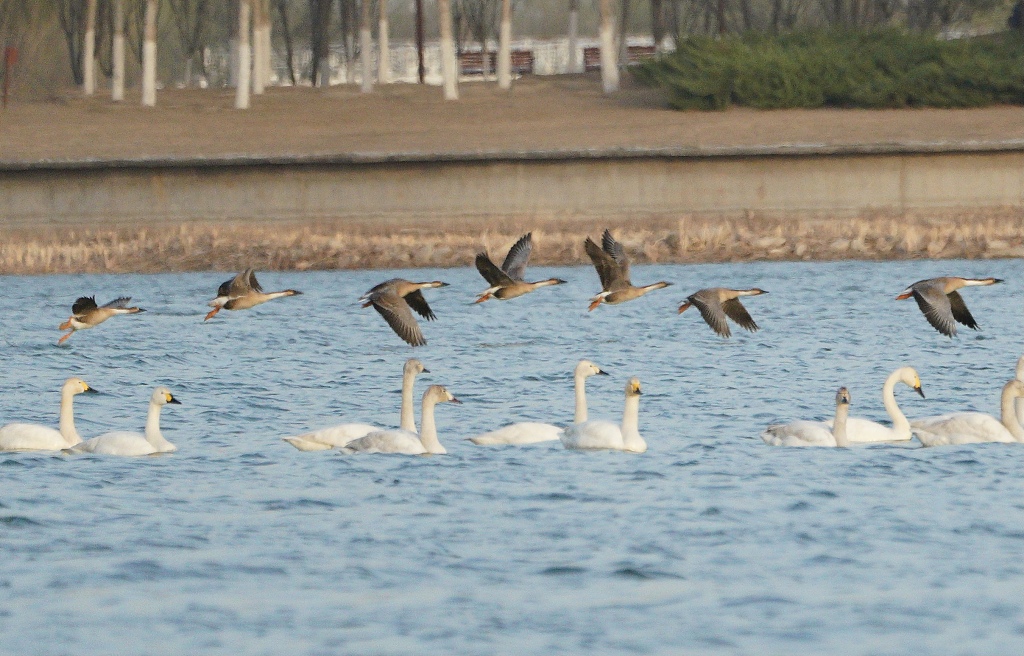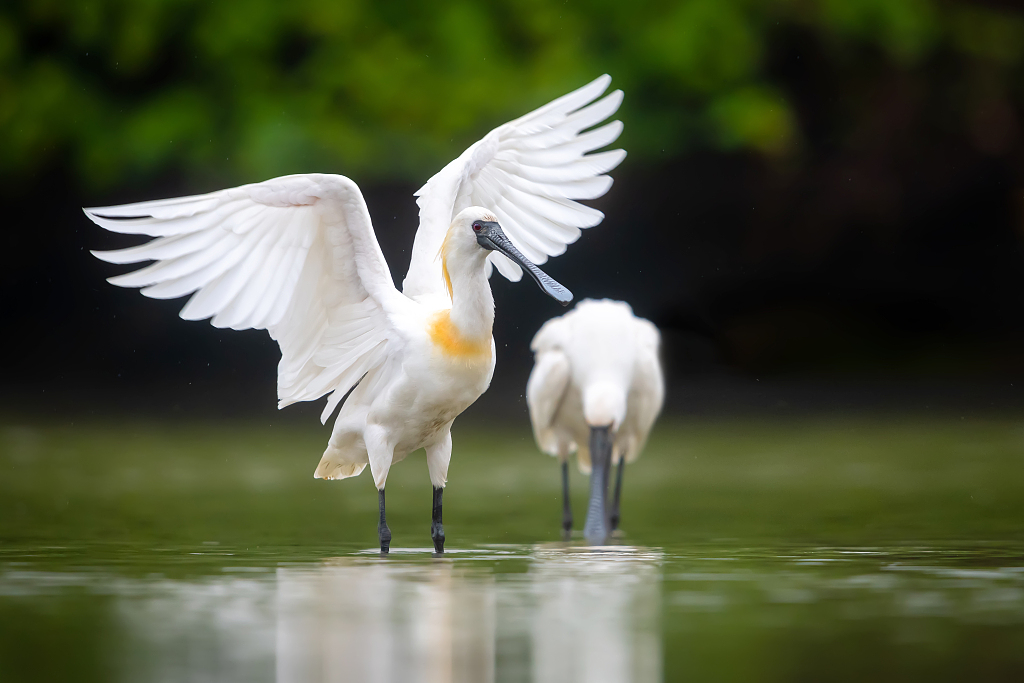When she spotted the first flock of Beijing swifts hovering above Beihai Park this year, Zhang Liting was extremely excited to see that her "old friends" had completed their thousand-mile journey.
The 39-year-old volunteer goes to the Beihai Park observation site at least once a week to record the population of Beijing swifts, providing tracking data and helping the birds migrate safely.

A flock of Beijing swifts fly across the Temple of Heaven in Beijing, China. /VCG
A flock of Beijing swifts fly across the Temple of Heaven in Beijing, China. /VCG
The Beijing swift, or the Apus apus pekinensis, is a typical migratory bird. These birds leave Beijing in mid-July to overwinter in South Africa, and return to Beijing in late April the following year.
Bird migration flyways are the stable routes that birds travel along between breeding and wintering sites. Four of the nine major bird migration flyways in the world pass through China.
Harboring rich biodiversity, including more than 1,400 species of birds, China plays an irreplaceable role in global migratory bird conservation. Thanks to the country's continued efforts to preserve biodiversity and conserve green ecosystems, an ever-growing number of people are joining in on migratory bird protection work.

Migratory birds in Nanhaizi Park of Beijing. /CFP
Migratory birds in Nanhaizi Park of Beijing. /CFP
Building bird-friendly cities
Beijing is a key point along the East Asian-Australasian Flyway (EAAF), one of the world's great flyways for migratory birds. It is an important stopover site for birds such as grey cranes and black storks, as well as Beijing swifts, on their northbound trips in the spring.
The latest list of Beijing's terrestrial wildlife shows that the city boasts 515 varieties of wild birds, ranking second among all the capital cities of G20 countries.
Amid efforts to ramp up the construction of an ecological civilization in Beijing, the natural environment and various wildlife species are being increasingly integrated into the fast-growing megacity with a population of over 20 million.
As of now, Beijing has established 79 protected nature areas, with the total areas reaching 368,000 hectares, bringing over 90 percent of key state-protected wildlife species and their habitats recorded in the city under effective protection. In 2021, the capital's forest coverage rate was 44.6 percent, and the green coverage rate of its urban areas was 49 percent.
Beijing's appreciation for and awareness of birds has skyrocketed in recent years. Many activities are held in public spaces and schools to promote the importance of protecting birds. Bird-friendly buildings are a common sight, and methods to prevent birds from crashing windows are improving.
"With the restoration of the ecological environment and rising public awareness, people and birds, hopefully, can become the best neighbors living under the same sky," said Jia Yifei, an associate professor at Beijing Forestry University.

Beijing swifts in Summer Palace of Beijing. /VCG
Beijing swifts in Summer Palace of Beijing. /VCG
Revitalizing bird habitats
In late March, a flock of black-faced spoonbills was seen foraging on the shores of east China's Fujian Province.
These birds have black and spoon-like beaks, and are one of the world's most endangered birds. They normally breed between May and July in northern regions and migrate southward to their winter roosting wetlands in October.
"The black-faced spoonbills were once rare to see here, but now they can be spotted every year and the number has remained stable," said Zheng Zhiwu, a birdwatcher who has been spotting birds at Luoyuan Bay in east China's Fujian Province for more than 20 years.
Decades ago, the disorderly expansion of aquaculture farms posed a great threat to the birds and damaged the ecosystem. To restore their habitat, the local government of Fujian has carried out multiple projects to restore key ecosystems, and transformed many fish-breeding ponds into bird habitats.
The profound change in Luoyuan Bay epitomizes China's ecological restoration efforts.

The black-faced spoonbills. /VCG
The black-faced spoonbills. /VCG
China in 1992 became a party to the Ramsar Convention, an intergovernmental agreement dedicated to the conservation and rational use of wetland ecosystems, and the country has since stepped up its conservation efforts while establishing a legal framework to govern wetlands.
During the 2016-2020 period, China undertook 53 wetland protection and restoration projects, and more than 2,000 wetland ecological compensation projects. It also undertook projects to return farmlands to wetlands, as well as wetland protection and restoration subsidy projects.
Over the past decade, China has added or restored more than 800,000 hectares of wetlands, according to the National Forestry and Grassland Administration.
The growing number of migratory birds seen in China speaks to an improving local natural environment, Zheng said. "Endangered birds have become frequent visitors thanks to the improved natural environment," he added.
Protection transcending borders
Flyways usually stretch across thousands of kilometers, spanning countries, oceans and continents. The EAAF, for example, stretches from the Russian Far East and Alaska, southward through East Asia and Southeast Asia, and on to Australia and New Zealand, encompassing over 20 countries and regions.
"Thriving migratory species need support from all countries along the entire flyway, so enhancing international cooperation is a must," said Guan Lei, a project manager at the Beijing Entrepreneur Environmental Protection Foundation.
However, experts warn that the protection of migratory birds and their flyways continues to face threats such as the loss and fragmentation of habitats, insufficient funding, and regional imbalances. "Only by working together to conserve their habitats can we provide more effective protection for the birds," Jia said.
China has always been a strong advocator for strengthened global cooperation. It has signed bilateral agreements on migratory bird conservation with countries such as Japan and Australia, and promotes migratory bird protection through multilateral environment treaties. Last year, China pledged to promote international exchanges and cooperation to protect the four flyways that pass the country.
Making big headway in that direction, China's Migratory Bird Sanctuaries along the coast of the Yellow Sea-Bohai Gulf (Phase I) were inscribed on the World Heritage List as a natural site in 2019.
"This inscription not only helps promote global efforts to protect the EAAF, but also injects vitality into the construction of a community for all life on Earth," Guan said.
Zhang Liting said she was gratified to see her 13-year-old daughter become a loyal bird guardian. "I believe Beijing swifts will make beautiful memories for future generations too," she said.
(If you have specific expertise and want to contribute, or if you have a topic of interest that you'd like to share with us, please email us at nature@cgtn.com.)
Source(s): Xinhua News Agency